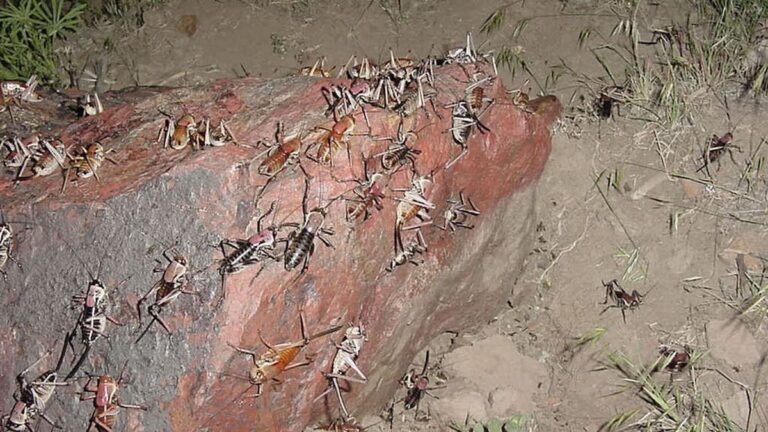Millions of “nightmare” Mormon crickets invade cities
An outbreak of Mormon crickets is sweeping through parts of Nevada, causing nightmares for residents and businesses.
Damien Henderson, Storyful
Parts of Nevada are being overrun by an explosion of cannibalistic flightless, ground-dwelling insects, creating nightmares of biblical proportions.
Businesses and residents said they are battling millions of Mormon crickets that have descended on the state this week in a bid to save the land and morale.
In Elko, a town in northeastern Nevada south of the Idaho border, crickets converged on Monday, covering streets, vegetation and even the walls of local hospitals, multiple media outlets reported.
“Just to get patients to the hospital we had people out there with leaf blowers, brooms, at one point we even had a tractor with a snowplow to push the piles of crickets and move them on their way,” Steve Burrows, manager community relations at Northeastern Nevada Regional Hospitalsaid the local KSL TV.
Native to western North America, crickets populations cycle over many years and some residents in the mini-metropolis of 20,000 people are not happy about their return.
“They're just gross,” said Precious Drake of Elko, in the report. “They look like spiders and they poop everywhere.”
The deadliest animals Which animal kills the most people annually? Protect yourself from this unexpected predator.
What do Mormon crickets eat?
According to the University of Nevada, Reno, Mormon crickets can grow more than two inches and are found in grasslands west of the Missouri River and throughout Nevada. They eat perennials, grasses, shrubs and crops, subsequently reducing forage for grazing wildlife and livestock.
Mormon crickets are also cannibals, and if their bellies are not full, they will eat each other dead or alive.
The insects aren't true crickets, but are “shielded, short-winged, fat grasshopper-like katydids that can't fly,” according to the university. Adult Mormon crickets have long antennae and a shiny exoskeleton in a wide variety of colors and patterns.
In mass quantities, their feeding contributes to soil erosionpoor water quality, nutrient depleted soils and other soil damage.
Mormon crickets prefer drought conditions and can cause “significant economic losses to pastures, crops and home gardens,” according to the university. “This is especially true as Mormon cricket adults and nymphs migrate in a band, eating plants along their paths.”
The Nevada Department of Agriculture did not immediately respond to USA TODAY Friday morning to say how many counties reported an offense.
'Delicious' Breathe, Swifties! He just swallowed a bug. Watch the moment Taylor swallows an insect on stage.
The name Buggers comes from Utah
Last June, farmers and government officials across Nevada northeast to Montana battled the insects as they destroyed crops.
The insect's name dates back to the 1800s, when the bugs destroyed the fields of Mormon settlers in Utah. However, amid drought and high temperatures – conditions favored by the insects – outbreaks in the West have worsened.
According Utah State Universityinfestation is when there are at least eight crickets per square yard of land.
Because Utah's spring has been cool and wet, only “a few minor infestations” have been reported so far this year, according to Utah Public Radio.
“Fat with the entrails squished”
In 2017, Arlington, Oregon, saw its largest outbreak of Mormon crickets since the 1940s. The streets were “greased with the writhing entrails of the enormous insects,” which damaged nearby wheat crops, the Associated Press reported.
Skye Krebs, a local rancher there, called the outbreak “truly biblical.”
“On the freeways, once you kill them, the rest come,” Krebs said.
Farmers experiencing infestation problems are encouraged to call their respective state Department of Agriculture.
Contributed by Associated Press
Natalie Neysa Alund covers breaking and trending news for USA TODAY. Contact her at nalund@usatoday.com and follow her on Twitter @nataliealund.



